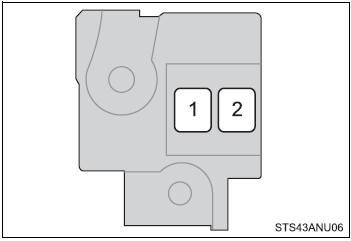 Toyota Yaris: Checking and replacing fuses
Toyota Yaris: Checking and replacing fuses
If any of the electrical components do not operate, a fuse may have blown. If this happens, check and replace the fuses as necessary.

Turn the engine switch to the “LOCK” position.

Open the fuse box cover.
Engine compartment (type A fuse box)

Push the tab in and lift the lid off.
Engine compartment (type B fuse box)

Push the tab in and lift the lid off.
Engine compartment (type C fuse box)

 Pull the rubber strip on the edge
to unhook it from the cover, and then push the tabs in and lift the cover off.
Pull the rubber strip on the edge
to unhook it from the cover, and then push the tabs in and lift the cover off.

 Remove the battery terminal cover
and then the fuse box cover.
Remove the battery terminal cover
and then the fuse box cover.
Under the driver’s side instrument panel

Remove the lid.

After a system failure, see “Fuse layout and amperage ratings” (→P. 279) for details about which fuse to check.

Remove the fuse.

Only type A fuse can be removed using the pullout tool.
The pullout tool is located on the back of the type A fuse box cover.

Check if the fuse is blown.
Type A

 Normal fuse
Normal fuse
 Blown fuse
Blown fuse
Replace the blown fuse with a new fuse of an appropriate amperage rating. The amperage rating can be found on the fuse box lid.
Type B

 Normal fuse
Normal fuse
 Blown fuse
Blown fuse
Replace the blown fuse with a new fuse of an appropriate amperage rating. The amperage rating can be found on the fuse box lid.
Type C

 Normal fuse
Normal fuse
 Blown fuse
Blown fuse
Replace the blown fuse with a new fuse of an appropriate amperage rating. The amperage rating can be found on the fuse box lid.
Type D

 Normal fuse
Normal fuse
 Blown fuse
Blown fuse
Replace the blown fuse with a new fuse of an appropriate amperage rating. The amperage rating can be found on the fuse box lid.
Type E

 Normal fuse
Normal fuse
 Blown fuse
Blown fuse
Replace the blown fuse with a new fuse of an appropriate amperage rating. The amperage rating can be found on the fuse box lid.
Type F

 Normal fuse
Normal fuse
 Blown fuse
Blown fuse
Contact your Toyota dealer.
Fuse layout and amperage ratings
Engine compartment (type A fuse box)




Engine compartment (type B fuse box)


Engine compartment (type C fuse box)


Under the driver’s side instrument panel



■After a fuse is replaced
●If the lights do not turn on even after the fuse has been replaced, a bulb may
need replacement. (→P. 287)
●If the replaced fuse blows again, have the vehicle inspected by your Toyota dealer.
■If there is an overload in a circuit
The fuses are designed to blow, protecting the wiring harness from damage.
■When replacing light bulbs
Toyota recommends that you use genuine Toyota products designed for this vehicle. Because certain bulbs are connected to circuits designed to prevent overload, non-genuine parts or parts non designed for this vehicle may be unusable.
■When reinstalling the cover (type C fuse box cover only)

Reinstall the cover, and then hook the rubber strip’s groove onto the cover.
CAUTION
■To prevent system breakdowns and vehicle fire
Observe the following precautions. Failure to do so may cause damage to the vehicle, and possibly a fire or injury.
●Never use a fuse of a higher amperage rating than that indicated, or use any
other object in place of a fuse.
●Always use a genuine Toyota fuse or equivalent.
Never replace a fuse with a wire, even as a temporary fix.
●Do not modify the fuses or fuse boxes.
NOTICE
■Before replacing fuses
Have the cause of electrical overload determined and repaired by your Toyota dealer as soon as possible.
 Wireless remote control battery
Wireless remote control battery
Replace the battery with a new one if it is depleted.
■ You will need the following items:
● Flathead screwdriver
● Lithium battery CR2016
■ Replacing the battery
Type A
...
 Light bulbs
Light bulbs
You may replace the following bulbs by yourself. The difficulty level of replacement
varies depending on the bulb. If necessary bulb replacement seems difficult to perform,
contact your Toyota dea ...
See also:
Luggage door opening front trough (ASSY): Sedan
REPLACEMENT
REMOVAL
INSTALLATION
Temporarily install the new parts and measure each part of the new parts in accordance
with the body dimension diagram. (See the body dimension diagram) Inspe ...
Rocker outer panel (CUT): Sedan
REPLACEMENT
REMOVAL
INSTALLATION
Temporarily install the new parts and measure each part of the new parts in accordance
with the body dimension diagram. (See the body dimension diagram) Inspe ...
Rear floor side panel extension (ASSY): Hatchback
REPLACEMENT
With the quarter panel and body lower back panel removed.
REMOVAL
INSTALLATION
Temporarily install the new parts and measure each part of the new parts in accord ...
